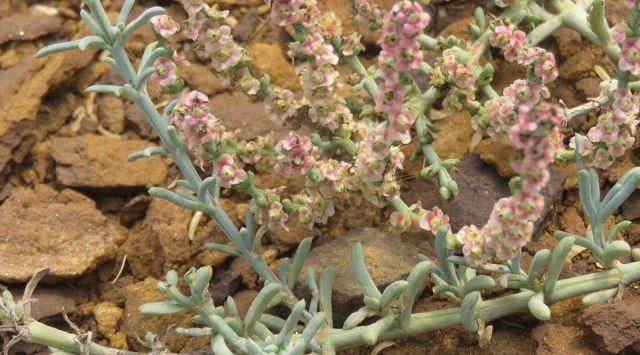New plant species that grows in saline conditions of Kutch discovered
Previously, Salsola kali, Salsola hatmanii, Salsola monoptera, Caroxylon imbricatum (Salsola baryosma) and Halogeton glomeratus (Salsola glomerata) were recorded in India.
 The newly discovered species is a perennial, succulent shrub. GEER Foundation
The newly discovered species is a perennial, succulent shrub. GEER Foundation A team of researchers from Gandhinagar-based Gujarat Ecological Education and Research (GEER) Foundation has discovered a new species of saltwort called Salsola Oppositifolia Desf., a perennial shrub that grows in saline, arid to semi-arid environments of the Kutch district.
The discovery of Salsola oppositifolia Desfontania, a species that belongs to the family of Amaranthaceae, has been reported in the latest issue of Plant Discoveries, an annual compendium published by the Botanical Survey of India (BSI) since 2007.
“This species, earlier known from Italy, Northern Africa, Palestine, Spain and Western Sahara, has been reported for the first time from India based on the collection made from Khadir Bet, Kutch, Gujarat at 15.5-m altitude. Specimens are deposited in the Herbarium of Gujarat Ecological Education and Research Foundation,” Plant Discoveries, 2022 published in June this year, reports.
The inclusion in Plant Discoveries comes nearly a year after scientists at GEER Foundation detailed their discovery in a research paper published in the July 2022 issue of the Journal of Threatened Taxa published by Coimbatore-based NGO, Wildlife Information Liaison Development Society.
The GEER Foundation team comprised Rakesh Gujar, Vinesh Gamit, Ketan Tatu and RK Sugoor. While Gujar and Gamit — both botanists — were then research fellows with GEER Foundation, Tatu, now the principal scientist of the foundation, was a senior scientist then. Sugoor is the director of GEER Foundation. Tatu was leading the team of researchers.
According to the research paper, the GEER Foundation researchers stumbled upon the new plant species in August 2021 while studying the flora and fauna of the Great Rann of Kutch (GRK) as part of a project assigned to them by the Gujarat Forestry Research Foundation (GFRF). Both GEER Foundation and GFRF are autonomous bodies functioning with support from the Gujarat forest department.
The new plant species, according to the paper, is a perennial, succulent shrub that can grow one to two metres tall and have a smooth, cylindrical, woody base. It is rarely prostrate and unlike other species of Salsola, does not have any hairs. As the name oppositifolia suggests, the leaves of this plant grow opposite each other in the stem. It is a halophyte — a plant adapted to growing in saline conditions.
Sugoor told The Indian Express that the discovery is significant due to the geo-ecological region in which it has been found. He underlined that besides being the habitat of Indian Wild Ass, a species categorised as near-threatened by the International Union for Conservation of Nature, GRK is also a habitat of a large number of bird species, including dozens of international migratory species.
“On the face of it, the discovery of the new plant species adds to our understanding of the biodiversity of GRK. But GRK is the habitat of dozens of migratory bird species, too, and in that context, it is important to study the ecological importance of this plant species. If it is found that some insects depend on this plant, then this species becomes important and the forest department may take appropriate decisions to propagate the species artificially,” said Sugoor.
Researchers said that during their study of flora and fauna of GRK, they found solitary plants as well as clusters of plants of Salsola oppositifolia Desfontania in the rocky and pebbled hilly outcrops of Khadir and Bela islands in GRK in the eastern part of Kutch.
Salsola oppositifolia Desfontania is the sixth species of Salsola genus to be discovered in India. “Five other species of Salsola genus have been found in India. But these plants looked morphologically different from the known species of the area and therefore, we studied them comprehensively and sought help from experts in identification and confirmation,” a researcher said. After prima facie concluding that the plant was Salsola oppositifolia Desfontania, the team sent plant specimens to SL Meena, a BSI scientist in Jodhpur, who confirmed that it indeed was Salsola oppositifolia and that it was the first record of the species in India.
Previously, Salsola kali, Salsola hatmanii, Salsola monoptera, Caroxylon imbricatum (Salsola baryosma) and Halogeton glomeratus (Salsola glomerata) were recorded in India. Salsola baryosma was also previously recorded in GRK.
Plants of the Salsola genus have salty juice stored in their leaves. “Locals in Kutch call plants of Salsola oppositifolia ‘morad’, a name they commonly use for Suaeda nudiflora (from the Amaranthaceae family), as they don’t understand the finer differences between the two species as both of them are halophytes,” Gamit told The Indian Express, adding, Salsola oppositifolia is used as a raw material for manufacturing soda ash. He said that other Salsola species are used in manufacturing lye and soaps and that research has established that the species of this genus are rich in pharmacological properties also.
Suaeda nudiflora and Suaeda fruticosa are also halophytes and are used as fodder in Kutch. The latter is locally called bethi unt morad. While unt, which literally means a camel, and refers to the tall height of the plant, bethi translates to sitting in reference to the plant that lies flat or prostrate on the ground. “In fact, Salsola fruticosa is also a species palatable to the Indian Wild Ass,” Tatu said.
Bhikhabhai Rabari, president of Kutch Unt Uchchherak Maldhari Sangathan (KUMMS), an organisation of camel breeders, said that both camels and buffaloes graze on unt morad and bethi morad in Kutch district.







